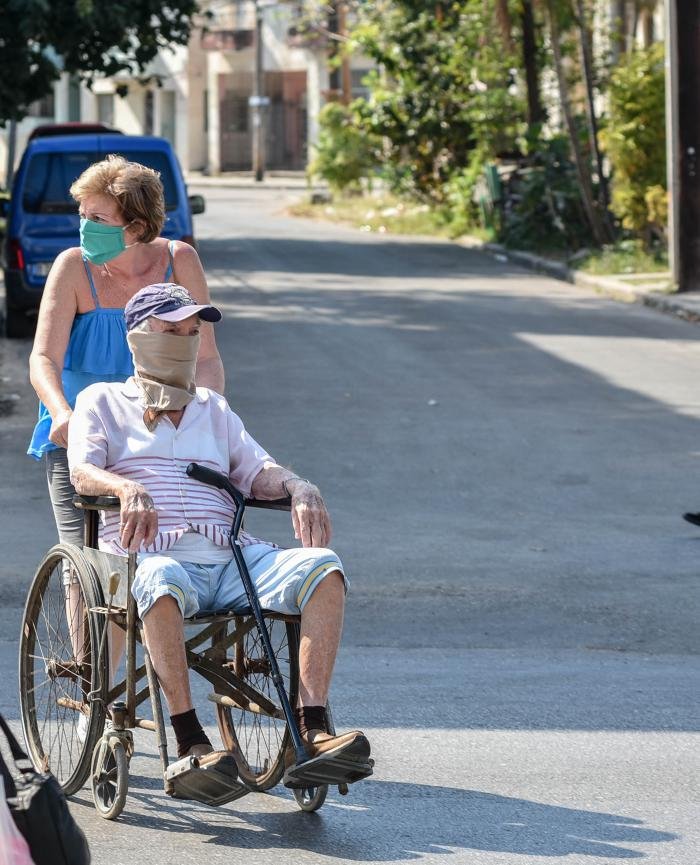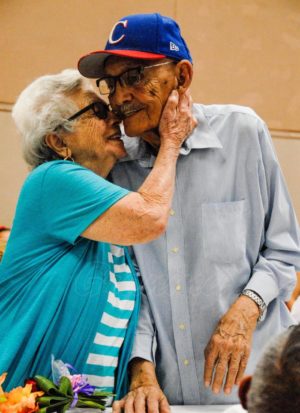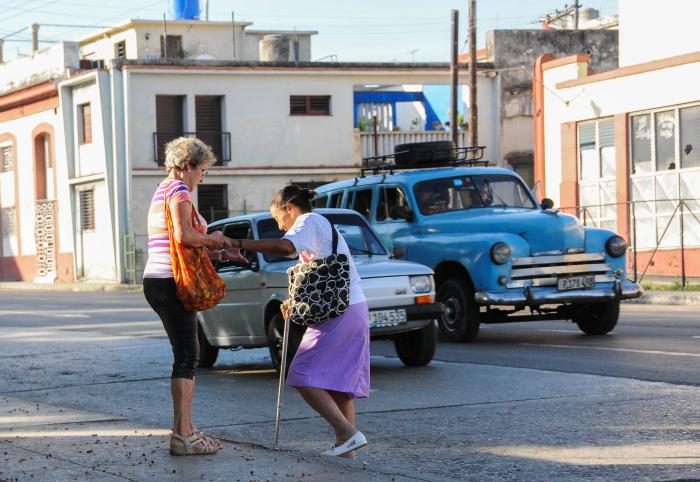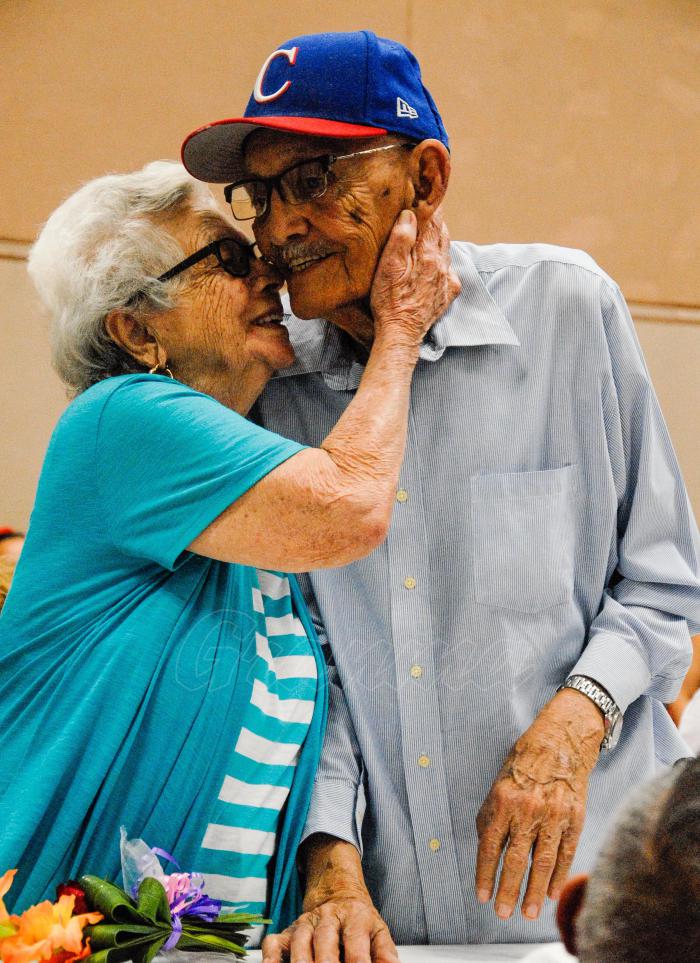Aging 3
Protecting Family Caregivers

The Other Side of Dependency:
Protecting Family Caregivers
Demographic aging is a phenomenon that poses multiple challenges at all levels, which are common to all societies
Translated and edited by Walter Lippmann for CubaNews.

Coronavirus, Ayestaran Street
Three-quarters of the elderly population in Cuba, who are in care, receive informal support, and it is the family that contributes most to this, and of these three quarters, 85% of the informal care is provided at home Photo: Ariel Cecilio Lemus
Demographic aging is a phenomenon that poses multiple challenges at all levels, which are common to all societies.
According to an article by the Center for Demographic Studies at the University of Havana, Cuba has been ranked, after Uruguay, as the country with the second-highest number of elderly people in Latin America and the Caribbean since 2015.
The statistics also reflect that in much of Europe, North America and in some Latin American countries, there is a considerable increase in the number of older people, even those over 85.
Added to this, is the number of people in a situation of disability, as well as the increase in the chronicity of illnesses, particularly neurodegenerative ones, factors that lead to an increase in the number of people dependent on care.
However, the analyses of the phenomenon of population aging have always weighed, more or less correctly, the approaches from the vantage point of those who receive care, and never, or almost never, “which is not the same, but it is the same”, from that of the caregivers.
The current legislation, according to Dr. Leonardo Pérez Gallardo, president of the Cuban Society of Civil and Family Law, of the National Union of Jurists of Cuba, does not contain any reference to the subject. Hence, this is probably one of the novel aspects to be incorporated in the new Family Code, which could be presented to the National Assembly of the People’s Power this year.
Afterward, there will be the popular consultation, discussion with the deputies and final approval, in a referendum, of the resulting text, as dictated by the Eleventh Transitory Provision of the Constitution.
OF CARE AND CAREGIVERS
Although dependency is not a new phenomenon, says Perez Gallardo, “the convergence of different factors such as demographic aging, increased life expectancy and changes in family structure, have led to it becoming a phenomenon that requires urgent and appropriate responses from political, technological, social, health, psychological, family, economic and, of course, legal.
The dependent person, he explains, requires assistance from others for a prolonged period, that is to say, it is not a question of attention for a passing illness, but it implies the need of assistance for those activities of the daily life. This care, constant and lasting, over a long period of time, has been called long-term care, and it involves the provision of assistance with progressive intensity.
Nor can it be lost sight of, in Pérez Gallardo’s opinion, that chronic illnesses and disabilities can be accompanied by functional and cognitive limitations that end up preventing people from enjoying an independent life.
In situations of this nature, family care generally takes on a more prominent role. The key, warns the professor at the University of Havana Law School, lies in the physical and emotional availability of a person to devote himself or herself regularly to the care of that family member, even to the point of giving up or reducing his or her productive or working capacity in order to satisfy the demands of the recipient of his or her services.
In Cuba, according to Dr. Leonardo Pérez, three-quarters of the elderly population in care receive informal support, and it is the family that contributes most to this. And of those three-quarters, 85% of informal care is provided at home.
INFORMAL CAREGIVERS PROTECTED?
Family caregivers, says the President of the Cuban Society of Civil and Family Law, are also called informal caregivers because, unlike professional caregivers, the former are engaged in care for a circumstantial reason, without specialized knowledge and without compensation.
Professional caregivers, on the other hand, are hired and receive financial compensation for their service. Informal caregivers, on the other hand, do so out of altruism, based on the moral duty they owe to their family members, who in many cases are their own parents.
Moral duty which, by the way, and as a lag in a patriarchal and androcentric society, is usually attributed to women, either as daughters, wives or sisters. It has even been assumed as “logical” that it is the children’s wives who take care of their in-laws, especially when they did not have female descendants.
Without a doubt, summarizes Pérez Gallardo, there are many and varied risks that the caregivers assume, because this activity implies, in the personal order, resignation to an adequate life. In the social order, it implies isolation and, in the professional order, loss of their productive capacity and even abandonment, total or partial, of their life project.
For this reason, he emphasizes, “it is necessary to regulate the rights of family caregivers so that the legal system can make them visible, based on the recognition of their autonomy and dignity, as well as the condemnation of any form of manifestation of family or gender violence against them.
“There is an urgent need for legislation that recognizes the right to their own care, to dedicate time to personal activities, to be treated with respect and to receive the due support of the rest of the family members. It is about protecting, from the Law, the other side of the care”.
The protection of caregivers, acknowledges the professor, “should not only be transversal in the field of public law, but also from the private law, capable of providing useful tools to compensate the asset imbalance associated with the performance of the work of caregiving.”
In the words of Pérez Gallardo, “it is necessary to focus on those people who, as caregivers, have been left socially and economically unprotected after the death of the care recipient. To this end, the rules of both family law and inheritance law can be important instruments.
“It would be worthwhile to think of alternatives that, without diminishing altruism, affection, solidarity, dedication and love, encourage care, compensate for silence, emotional and physical overload and facilitate an equitable and fair redistribution of the inheritance”.
In that sense, he points out, “the freedom to bequeath can be a useful alternative and within everyone’s reach. Nobody better than the one leaving [material resources] to compensate the efforts of the caregiver. And, in the absence of the exercise of the power to bequeath, it will be up to the legislator, as they see fit, to establish the best correlation between participation in the inheritance and care for that person in the twilight of life”.
The Chinese model, he suggests, “could be a mirror for the succession rules, from the establishment of more and more flexible rules in the legal succession, suitable to give an answer to the dissimilar social equations that this 21st century has been establishing, in pursuit of a distributive justice in favor of the caretakers”.
IN CONTEXT
The constitutional text, proclaimed on April 10, 2019, establishes in Chapter III Families, of Title v Rights, Duties and Guarantees that
The State, society and families, as far as each one is concerned, have the obligation to protect, assist and facilitate the conditions to satisfy the needs and raise the quality of life of the elderly. Likewise, to respect their self-determination, guarantee the full exercise of their rights, and promote their social integration and participation.
The State, society and families have the obligation to protect, promote and ensure the full exercise of the rights of persons in a situation of disability. The State creates the conditions required for their rehabilitation or the improvement of their quality of life, their personal autonomy, and their social inclusion and participation.
Women the Third Age of Their Sexuality

Everything about health
Women and the Third Age of Their Sexuality
Countless myths have historically reinforced stigmas about sexuality after people reach the sixth decade of life and come to consider themselves as adults and older adults.
Author: Lisandra Fariñas Acosta | internet@granma.cu
July 7, 2019 20:07:50
A CubaNews translation.
Edited by Walter Lippmann.

It is essential that the family accept the sexuality of the elderly. Photo: Dunia Álvarez Palacios
Countless myths have historically reinforced stigmas about sexuality after people reach the sixth decade of life and come to see themselves as adults and older adults.
These myths, in the case of women, “conceived under the stereotype of mother, woman as a function of the family”, have hindered their enjoyment of sexuality, and which increases in the so-called third age.
This is what Dr. Beatriz Torres Rodríguez, president of the Cuban Society for the Multidisciplinary Study of Sexuality (Socumes), said at the recently held XVII Congress of the Cuban Society of Gynaecology and Obstetrics, addressing this issue.
“Women are prepared to attend to and satisfy the needs of others. Socially, there is a predominant belief that her sexual capacity and desire are less than those of men, and that female love is romantic and must have an erotic passivity,” the specialist said.
This is accompanied by other myths such as that only in youth you enjoy a good sexuality and that women in old age do not have an active sexual life, and are not interested in engaging in some romantic relationship, said the expert.
When talking about women’s sexuality in old age, many times we only think about the following aspects: fragility and loss of pubic hair; the vaginal mucosa dries up and atrophy, thus diminishing its secretion and facilitating infections; the vulva, labia minora and clitoris decrease in size, there is a shortening and narrowing of the vagina; the ovaries decrease in size, and the cervical mucus is thick, scarce and cellular; the breasts become flaccid as a result of the atrophy of the tissues and the lack of hormonal secretion.
For the psychologist, it is essential to take into account what older women think and what is meant by geriatric sexual health.
The latter is “the psychological expression of emotions and commitments that requires the greatest amount and quality of communication between partners, throughout existence, in a relationship of trust, love, ability to share and pleasure, with or without intercourse,” according to specialized literature.
This concept is fundamentally based on an “optimization of the quality of the relationship” (more than in quantity), said Dr. Torres Rodriguez.
For the interviewee, several elements cannot be lost sight of: self-perception of sexual attractiveness is a very important social factor.
“The climacteric anticipates the “feeling of old age” in many women. A large number of women mistakenly believe that once their reproductive function is over, sexual function is also lost,” she said.
Added to this is the fact that older people find it very difficult to consult medical science professionals, because there is a general lack of training in areas of sexuality and, even more so, in the sexuality of older people. Hence, the role of health professionals in general and family physicians, as well as specialists in Geriatrics, as key health providers at this stage must become essential.
It is essential that the person is cared for from a holistic point of view and that, for example, sexual dysfunctions are taken as seriously as high blood pressure or diabetes.
Studies carried out in our context have shown that, contrary to what many people think, a considerable part of dysfunctions in old age have their origin in ignorance, false expectations, feelings of being handicapped and other phenomena. These, although they play an important role in the appearance of dysfunctions, are relatively easy to combat and prevent by means of adequate information and discussion.
According to epidemiological studies, the fact of losing one’s partner is one of the most important determinants of the cessation of sexual activity.
“Traditionally, there has been a strong social tendency to consider negatively the establishment of new affective relationships, and even new marriages in widows, which further limits their sexual activity,” said the psychologist.
In general, it is essential that the family accept the sexuality of the elderly, consider the possibilities of second and third marriages, and respect the privacy of the parents and grandparents.
Older women’s sexuality as an indicator of quality of life, especially perceived quality of life, requires a better understanding of all factors affecting it. One of the most important is mourning, for the body, for sexual and social losses.
But what does old age really imply or limit? On the subject, the experts William Masters and Virginia
Johnson, who are dedicated to the study of human sexual response, argue that the elderly can have sex at any age.
An international survey of 1126 elderly people, conducted by the University of Michigan, showed that 30% were sexually active and showed that sexual dysfunction is not inherent in aging.
Hence the need to influence the understanding of the sexual changes that occur in old age and the negative influence that myths and beliefs have on the enjoyment of sexuality in women over the age of 60. “Sexuality is not only for young people,” explains Dr. Beatriz Torres Rodríguez.
Promoting knowledge about the rights of the elderly to enjoy their sexuality and promoting public policies that do not only correspond to the health sector is essential. The idea is to encourage spaces for socialization, recreation and growth in these stages of life, without neglecting family education in these areas.
IN CONTEXT:
- Cuba, with 20.4% of its population aged 60 and over, according to data from the National Statistics and Information Office (ONEI), is experiencing an accelerated process of demographic aging.
- Data from the last Population and Housing Census show a high incidence of single-person households, where there is a significant presence of older adults.
- In 40% of Cuban households, there is an elderly person. In 32% of them reside up to two or three persons 60 years old and over, so it is very likely that an older adult is caring for the other (especially women).
- The high prevalence of fragility, disability and dependence of older adults leads to a growing demand for care and social protection.
- In addition, current and future trends indicate that levels of demographic aging and declining population will continue to be reinforced.
- Considering the three fundamental demographic variables and their influence on aging, the decisive effect of (low) fertility, the much smaller effect of mortality and the non-negligible and probably substantial influence of external and internal migrations for the country and for some regions is confirmed.
- As a perspective of the demographic dynamics between 2011 and 2025, Cuba’s population will have decreased in absolute terms, almost 26% of its population will be 60 years old and over, with a high absolute growth of 80 years and over. By 2030, there will be 3.3 million people aged 60 and over, with direct impacts on the family and labor resources.
- “One of the most depressing circumstances for older adults is loneliness. This situation becomes more evident with the loss of marital ties (in the case of women they face greater widowhood than their male peers),” said Dr. Torres Rodriguez.
Falls Can and Should be Prevented

ALL ABOUT HEALTH
Falls Can and Should be Prevented
Falling is a geriatric syndrome, a disease; when it becomes recurrent it is clearly giving alarm signals that must be paid attent to.
Author: Lisandra Fariñas Acosta | lisandra@granma.cu
October 28, 2018 20:10:34
A CubaNews translation.
Edited by Walter Lippmann.

As we age we must adapt to the environment, which is often a challenge for the performance of activities of daily living, crossing streets, transportation, ant the footwear that is used, can cause of fractures on numerous occasions. Photo: Juvenal Balán
“It took human beings about five million years to learn to walk and only 70 years to fall. This, which humorously may be interesting, should not really be allowed, because falling is not a habitual state. Falling is a geriatric syndrome, a disease. In other words, not everyone falls, because there are people who reach the age of 90 without having suffered any event of this type.
This was explained to Granma by the doctor of the Argentine Association of Orthopedics and Traumatology and member of AO Trauma, Emilio Fantin. He emphasized the need to prevent falls in the elderly, an aspect that is not often thought of. For the expert, it is important not only to know what a fall is, but also to understand why we fall and to evaluate the old person who falls.
Participating in the Seminar AO Trauma “Traumatology in the Elderly”, which was held in recent days in the teaching Fructuoso Rodriguez orthopedic hospital, and included recognized experts from this organization, Dr. Fantin commented that if we take into account that 1 to 5% of falls end in fracture and almost all hip fractures are secondary to them, it is vital to talk about this issue.
After a hip fracture, between 20 and 50% of older people fall again within two to six months of the first fall, so that prevention is once again the key. It happens that of those who fall for the second time, approximately 12% have a new fracture and 5% a hip fracture.
According to the World Health Organization (WHO), there are a thousand hip fractures per million inhabitants. If this figure is taken to the aging population, it is considered that a thousand fractures occur for every 100,000 people over 60 years of age, which would correspond to 10% of this age group.
It is estimated that around 12,000 of these fractures occur annually in Cuba, with resulting costs that they imply for the patients, the family, the health system and society in general.
20.1% of the Cuban population is 60 years of age or older, as shown by data from the Center for Population and Development Studies of the National Office of Statistics and Information. According to the latest Population and Housing Census (2012), 40% of Cuban households are inhabited by older adults. In 32% of them reside up to two or three persons of 60 years or more, so it is very likely that an older adult is caring for the other, and 13% of older adults live alone.
WHEN ARE YOU AT RISK OF FALLING?
The fall causes worries from the first moment, but when it becomes something recurrent (two or more falls in the space of a year) is clearly giving alarm signs that should be addressed, warned the specialist.
At the same time,” said the interviewee, “we must pay more attention when patients tell us “I have no strength, I fall, what can I do?
In Dr. Fantin’s opinion, the first thing is to think that falls are not normal events, because the fact of being old does not necessarily imply falling. Why does it happen? It has to do with physiology and physical structure, loss of bone and muscle mass, and functions such as hearing and sight.
But these aren’t the only causes, he explained. As we age, we must adapt to the environment, which is often aggressive in carrying out the activities of daily living. The streets, the transport, the footwear that is used, derive in reason of fractures in numerous occasions.
With respect to the profile of the older adult who falls and fractures, the professor pointed out that generally they are over 80 years old, there is a poor self-perception of their state of health, cognitive deterioration, that is, of the state of consciousness, and many have depression. To this is added the presence of visual and motor deficits, because a large part of this age group needs help to walk, using walkers, canes or someone who accompanies them.
“Even if we investigate, we can find stories of falls that deny us, or do not tell because they are ashamed. It is very rare for an older person to confess to a child who has fallen. They come to the bathroom with the fracture, but they usually fall for longer: in the early morning when they go to the bathroom, for example. Falls can also be related to the consumption of certain medications and polypharmacy, which can cause fragility and gait disturbances due to unbalance,” he said.
When evaluating a patient at risk of falling, the expert commented that intrinsic and external factors must be taken into account, in addition to others that may precipitate this fact, such as alcohol consumption.
Among the intrinsic causes, diabetes is one of the most frequent, followed by the state of consciousness, that is, dementia, delirium, or depression. A third place is given to diseases where muscle mass decreases, and the fourth element is the female sex, since a greater number of falls occur in women than in men.
Regarding external factors, the interviewee mentioned domestic animals, sidewalks, stairs, public transportation and medication.
“More than four drugs a day are considered polypharmacy, and this is a cause of falls, so making adjustments to prescribed drugs is essential. The older adult is given a medication and it is never taken away, they leave it forever,” explained Dr. Fantin.
In addition, the interviewee pointed to osteoporosis, tobacco use (mainly in women) and vitamin D deficiency, as other elements not to be lost sight of. “Older adults don’t sunbathe regularly, and it’s important to get them out in the sun. The amount of ultraviolet light needed to convert vitamin D, either from the diet or as a medicine, is 10 minutes, you don’t have to go to the beach, and you just have to discover your hands and face.
The ideal,” he said, “is to treat these fractures within 48 hours of their occurrence, which has allowed mortality in the world from this cause to decrease from 30 to 10%.
Particular emphasis was made by the expert in post-cause syndrome. “Whoever falls and fractures is afraid of falling again and the great majority does not return to their previous state. Anxiety disorder is very serious, and there is a tendency to the syndrome called immobility, which can even lead to death. For each day of rest, 1% of body mass is lost,” explained Dr. Fantin, who placed great importance on family support.
It is fundamental that prevention also begins at an earlier age, stimulating, for example, exercises such as the use of bicycles, which are less expensive, ideal for recovering muscles, stimulating the semi-circular ducts of the ears and making it easier for people to have balance, concluded the interviewee.
ACCURACY
– AO Trauma is one of the four clinical subdivisions of the AO Foundation (Working Group to Study Fracture Problems) created in Switzerland in 1958. Its purpose was the integrating and aligning of efforts in research, community development, and education in Traumatology and Orthopedics at the global and regional levels.
– According to Dr. Roberto Balmaseda Manent, secretary of the Cuban Society of Orthopedics and Traumatology, it has been particularly useful for the training and improvement of specialists in this branch.
– About 600 professionals from all regions of the country have had the opportunity to be trained step by step in the courses, workshops and seminars that the Society has organized.
Subscribe to Blog via Email
| M | T | W | T | F | S | S |
|---|---|---|---|---|---|---|
| 1 | 2 | 3 | 4 | 5 | 6 | 7 |
| 8 | 9 | 10 | 11 | 12 | 13 | 14 |
| 15 | 16 | 17 | 18 | 19 | 20 | 21 |
| 22 | 23 | 24 | 25 | 26 | 27 | 28 |
| 29 | 30 | 31 | ||||


You must be logged in to post a comment.